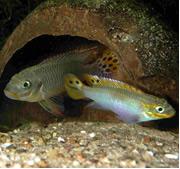Thanks to a friend of FME who sent me this article. Back in 2007,
 Timo Thünken
Timo ThünkenGiven a choice, the cichlid Pelvicachromis taeniatus, often found in aquariums, prefers to mate with siblings nearly three times out of four.Doesn't sound like the Westermarck Effect is present in them.
And males who shacked up with their sisters spent more time guarding their fry and less time fighting with their mate than unrelated couples.Sounds like they are protecting their genes.
The end result was happy families and healthy kids.Imagine that.
While a normal copy of a gene can sometimes mask a mutation, offspring that inherit two mutated copies lack any such protection. This can make inbred offspring less able to survive or reproduce.While I'm always cautious about applying what happens in other species to humans, I do find reports like this to be interesting when people insist that incest is not natural or that consanguineous reproduction will be problematic. Many humans experience the Westermarck Effect. Some don't. And, of course, those raised apart from their genetic siblings or genetic parents aren't going to experience the Westermarck Effect if they are introduced to, or reunited with them after becoming sexually mature.
But Timo Thünken and his collaborators at the University of Bonn in Germany found that inbred and outbred P. taeniatus had the same growth and survival rates. These results, together with recent studies in birds and other fish, suggest that the popularity of inbreeding in the animal kingdom may have been underestimated, Thünken says.
The same phenomenon has been seen in some insects and other fish species says William Shields, an evolutionary biologist at the State University of New York in Syracuse. "We still deal with the overriding dogma that inbreeding is deleterious," says Shields, "but there's evidence from lots of organisms that inbreeding can have advantages."Perhaps the most common argument used against the consanguineous freedom to marry is Discredited Argument #18. But it just doesn't hold up, which is why it is discredited.
Furthermore, it only takes three or four generations of inbreeding to purge the gene pool of many of the mutations that initially make it harmful, says Shields.
 Timo Thünken
Timo ThünkenGiven a choice, the cichlid Pelvicachromis taeniatus, often found in aquariums, prefers to mate with siblings nearly three times out of four.Doesn't sound like the Westermarck Effect is present in them.
And males who shacked up with their sisters spent more time guarding their fry and less time fighting with their mate than unrelated couples.Sounds like they are protecting their genes.
The end result was happy families and healthy kids.Imagine that.
While a normal copy of a gene can sometimes mask a mutation, offspring that inherit two mutated copies lack any such protection. This can make inbred offspring less able to survive or reproduce.While I'm always cautious about applying what happens in other species to humans, I do find reports like this to be interesting when people insist that incest is not natural or that consanguineous reproduction will be problematic. Many humans experience the Westermarck Effect. Some don't. And, of course, those raised apart from their genetic siblings or genetic parents aren't going to experience the Westermarck Effect if they are introduced to, or reunited with them after becoming sexually mature.
But Timo Thünken and his collaborators at the University of Bonn in Germany found that inbred and outbred P. taeniatus had the same growth and survival rates. These results, together with recent studies in birds and other fish, suggest that the popularity of inbreeding in the animal kingdom may have been underestimated, Thünken says.
The same phenomenon has been seen in some insects and other fish species says William Shields, an evolutionary biologist at the State University of New York in Syracuse. "We still deal with the overriding dogma that inbreeding is deleterious," says Shields, "but there's evidence from lots of organisms that inbreeding can have advantages."Perhaps the most common argument used against the consanguineous freedom to marry is Discredited Argument #18. But it just doesn't hold up, which is why it is discredited.
Furthermore, it only takes three or four generations of inbreeding to purge the gene pool of many of the mutations that initially make it harmful, says Shields.






 3:01 PM
3:01 PM
 Unknown
Unknown

 Posted in:
Posted in: 




0 comments:
Post a Comment